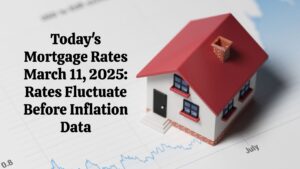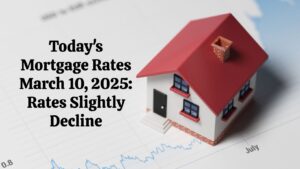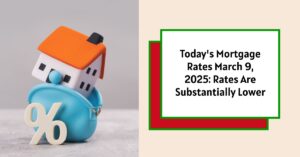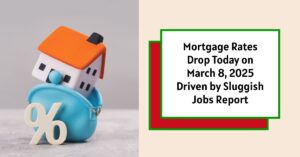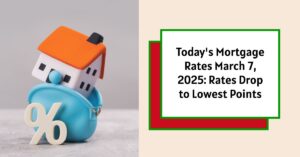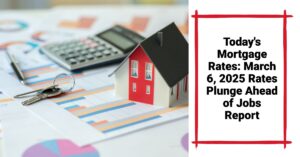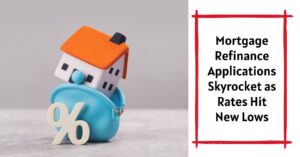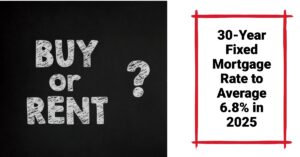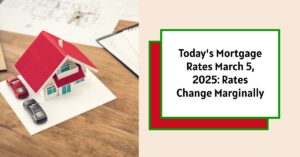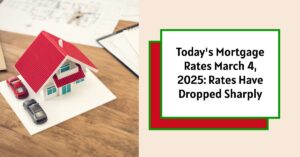As of today, March 11, 2025, mortgage rates are showing signs of fluctuation, with the 30-year fixed interest rate increasing slightly to 6.34%, while the 15-year fixed rate has decreased to 5.62%. These shifts are primarily influenced by upcoming inflation data, which is projected to impact future interest rates. Homebuyers and those looking to refinance should keep a close watch on these trends.
In the current economic climate, understanding mortgage rates is essential for any potential homebuyer or homeowner considering refinancing. The interplay between current market conditions, Federal Reserve policies, and external economic indicators can create a complex landscape.
Today's Mortgage Rates March 11, 2025: Rates Fluctuate Before Inflation Data
Key Takeaways
- Current Rates:
- 30-year Fixed: 6.34% (up)
- 15-year Fixed: 5.62% (down)
- Upcoming Data: Key inflation reports will be released this week.
- Potential Impact: Changes in rates could depend on the inflation trends observed.
Mortgage rates are a crucial factor for homebuyers and owners looking to refinance. They directly affect monthly mortgage payments and the overall cost of purchasing a home. Understanding these rates can help you make informed decisions in your home buying journey.
Current Mortgage Interest Rates
Here are the national averages for mortgage rates as reported by Zillow:
| Loan Type | Current Rate |
|---|---|
| 30-year Fixed | 6.34% |
| 20-year Fixed | 6.09% |
| 15-year Fixed | 5.62% |
| 5/1 ARM | 6.32% |
| 7/1 ARM | 6.28% |
| 30-year VA | 5.78% |
| 15-year VA | 5.23% |
| 5/1 VA | 5.82% |
These rates give a snapshot of the current mortgage landscape, reflecting national averages. It's important to note that these figures can fluctuate daily based on market conditions.
Current Mortgage Refinance Rates
For those looking to refinance, the following are the current refinance rates as per Zillow:
| Refinance Option | Current Rate |
|---|---|
| 30-year Fixed | 6.34% |
| 20-year Fixed | 5.97% |
| 15-year Fixed | 5.67% |
| 5/1 ARM | 6.53% |
| 7/1 ARM | 6.50% |
| 30-year FHA | 6.01% |
| 15-year FHA | 5.37% |
Refinance rates tend to be slightly higher than mortgage purchase rates, as lenders account for various risk factors involved in refinancing existing loans.
Exploring the Mortgage Options
While traditional fixed-rate mortgages are often the go-to choice for many buyers, there are various mortgage products available to meet different financial needs. Exploring each option can provide insights into which might be the best fit for your situation.
- Fixed-Rate Mortgages:
- As mentioned, fixed-rate mortgages provide stability by locking in your interest rate for the loan's duration. This means your monthly payments for principal and interest remain the same, making it easier for you to budget over time.
- Adjustable-Rate Mortgages (ARMs):
- ARMs can feature lower initial rates that reset after a specified period, such as 5 or 7 years. While they may offer significant savings upfront, the uncertainty associated with possible rate adjustments can pose financial risks to borrowers if market rates rise.
- Veterans Affairs (VA) Loans:
- For eligible veterans, active-duty service members, and some members of the National Guard and Reserves, VA loans offer favorable terms, such as no down payment and lower interest rates, making homeownership more accessible to those who have served in the military.
- Federal Housing Administration (FHA) Loans:
- FHA loans are designed to assist low to moderate-income borrowers. They require lower minimum down payments and lower credit scores than many conventional loans. This can be an excellent option for first-time homebuyers looking for a more welcoming entry into the housing market.
Recommended Read:
Mortgage Rates Trends as of March 10, 2025
Mortgage Rates Drop: Can You Finally Afford a $400,000 Home?
Mortgage Rates Forecast March 2025: Will Rates Finally Drop?
Expect High Mortgage Rates Until 2026: Fannie Mae's 2-Year Forecast
Impact of Upcoming Inflation Data
The Bureau of Labor Statistics is set to release the February Consumer Price Index (CPI) on March 12, followed by the Producer Price Index (PPI) on March 14. These reports can provide valuable insights into inflation trends, influencing how the Federal Reserve may respond and, consequently, affecting mortgage rates. In essence, if inflation is high, interest rates may rise to cool down the economy. Conversely, if inflation is lower than anticipated, interest rates may remain steady or potentially drop.
Understanding inflation’s role is especially pertinent now. Economic conditions like unemployment rates, consumer spending behaviors, and wage growth all intertwine with inflationary pressures. Additionally, if inflation consistently surpasses the Fed’s target, we could see a tightening of monetary policy, leading to increased interest rates – something that directly affects mortgage costs.
Monthly Mortgage Payment Calculations
To give you an idea of what your monthly payments might look like under these current rates, here’s a breakdown for various mortgage amounts based on the 30-year fixed rate of 6.34%.
Monthly Payment on $150,000 Mortgage
- Estimated Monthly Payment: $934.56
This amount includes principal and interest but excludes other costs.
Monthly Payment on $200,000 Mortgage
- Estimated Monthly Payment: $1,245.57
Again, this figure reflects solely the principal and interest components.
Monthly Payment on $300,000 Mortgage
- Estimated Monthly Payment: $1,868.36
Potential buyers should account for additional costs such as taxes and homeowners insurance.
Monthly Payment on $400,000 Mortgage
- Estimated Monthly Payment: $2,491.15
Higher mortgage amounts naturally lead to increased monthly financial responsibilities.
Monthly Payment on $500,000 Mortgage
- Estimated Monthly Payment: $3,113.94
This payment might seem daunting, but evaluating one’s budget and lifestyle can help determine affordability.
These estimates provide a general understanding of how the current rates impact monthly mortgage payments. It's essential to remember that these calculations do not include property taxes, homeowner's insurance, or private mortgage insurance, which can add significantly to your monthly costs.
Fixed-Rate vs. Adjustable-Rate Mortgages
When considering a mortgage, you have the option between fixed-rate and adjustable-rate mortgages (ARMs). A fixed-rate mortgage locks in your interest rate for the life of the loan, providing stability in payment amounts. In contrast, ARMs often offer lower initial rates, but these can fluctuate over time, potentially increasing your monthly payments after the initial period ends.
With the current economic climate and the Federal Reserve's cautious stance on interest rates, a fixed-rate mortgage could provide peace of mind for long-term planning. Conversely, an ARM may appeal to those planning to move or refinance in the near future.
Historical Context of Current Rates
In terms of historical comparison, today’s rates are elevated compared to the lows seen just a few years back. During 2021 and early 2022, many borrowers enjoyed rates below 3%. As we assess current rates, it’s crucial to understand that rate increases often reflect larger economic trends, including recovery from the COVID-19 pandemic, labor market dynamics, and shifts towards a more inflation-prone economy.
As we consider historical shifts, the Federal Reserve has utilized various tools to influence these rates, notably during financial crises. In response to economic downturns, the Fed has previously reduced the federal funds rate to stimulate growth; however, the current focus is on managing inflation while maintaining economic stability.
Future of Mortgage Rates
As we look ahead, mortgage rates are expected to remain volatile. Analysts suggest that any significant changes in the Federal Reserve's approach to interest rates based on inflation data could lead to adjustments in mortgage rates.
While some experts anticipate that rates may lower slightly as economic conditions stabilize, others remain cautious, emphasizing that no drastic moves are expected in the short term. Whether you're looking to buy a home or refinance an existing mortgage, staying informed about these trends is vital in navigating your options effectively.
My Personal Insight
In my opinion, the current mortgage rates reflect a pivotal moment in economic policy and market dynamics. Factors such as inflation, consumer confidence, and government policies intertwine to shape buyer behavior and lender responses. For potential homebuyers, now may be a challenging time, but being informed is empowering.
Even if current rates aren't at their lowest, knowing how they function within the economy can grant you a tactical advantage. For those willing to monitor the market and act strategically when favorable conditions arise, homeownership remains an achievable and worthwhile goal.
Work With Norada, Your Trusted Source for
Real Estate Investments
With mortgage rates fluctuating, investing in turnkey real estate
can help you secure consistent returns.
Expand your portfolio confidently, even in a shifting interest rate environment.
Speak with our expert investment counselors (No Obligation):
(800) 611-3060
Recommended Read:
- Mortgage Rate Predictions 2025 from 4 Leading Housing Experts
- Mortgage Rates Forecast for the Next 3 Years: 2025 to 2027
- 30-Year Mortgage Rate Forecast for the Next 5 Years
- 15-Year Mortgage Rate Forecast for the Next 5 Years
- Why Are Mortgage Rates Going Up in 2025: Will Rates Drop?
- Why Are Mortgage Rates So High and Predictions for 2025
- Will Mortgage Rates Ever Be 3% Again in the Future?
- Mortgage Rates Predictions for Next 2 Years
- Mortgage Rate Predictions for Next 5 Years
- Mortgage Rate Predictions: Why 2% and 3% Rates are Out of Reach
- How Lower Mortgage Rates Can Save You Thousands?
- How to Get a Low Mortgage Interest Rate?
- Will Mortgage Rates Ever Be 4% Again?
